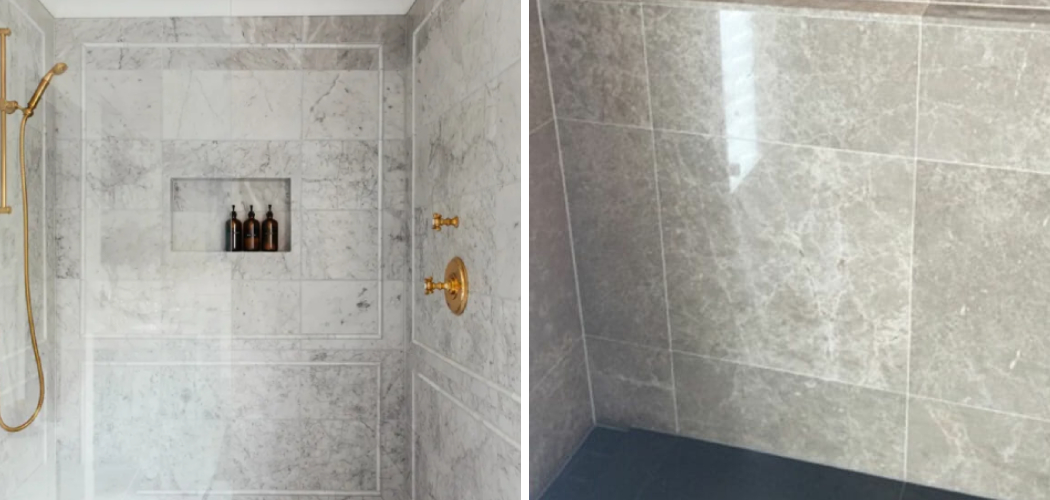Marble showers are a luxurious addition to any bathroom, adding a touch of elegance and sophistication. However, marble is a porous material that requires special care and maintenance to keep it looking its best.
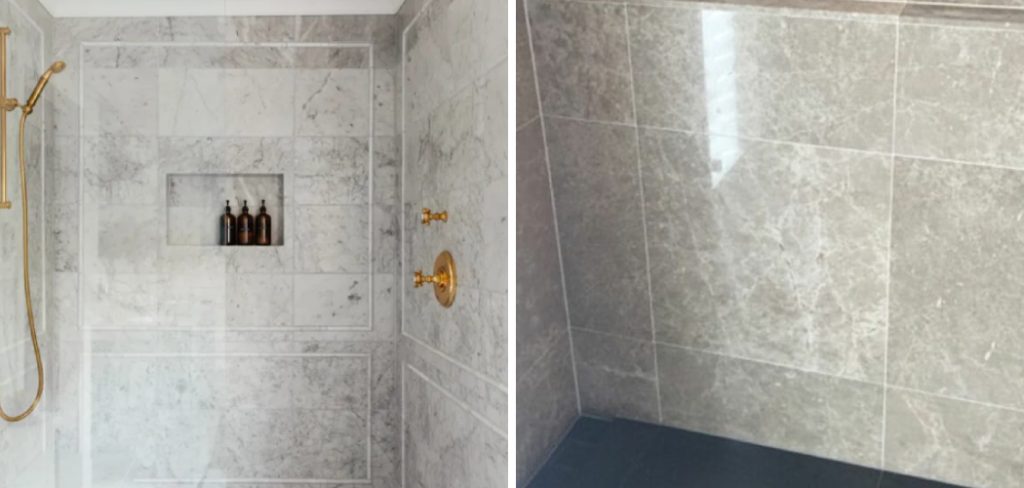
One crucial step in maintaining your marble shower is sealing it properly. Sealing helps protect the marble from staining and damage caused by water or other substances. In this guide, we will discuss how to seal marble shower effectively and keep it looking like new for years to come. So, let’s get started!
Why is Sealing Important?
Marble is a natural stone that is composed of calcium carbonate, making it susceptible to staining and etching. When exposed to water or acidic substances, such as certain cleaning products or citrus fruits, the surface of the marble can become dull or discolored. Sealing creates a barrier on the surface of the marble, preventing these substances from penetrating and causing damage.
Understanding Marble and Its Vulnerabilities
Before learning how to seal a marble shower, it is essential to understand the properties of marble and why it requires sealing. Marble is a metamorphic rock that forms from limestone under high pressure and heat. This process creates a unique veining pattern and gives marble its beautiful appearance. However, this also makes it prone to scratching, staining, and etching.
Marble has a porous structure with tiny holes and fissures that can absorb liquids and cause discoloration. It is also a relatively soft stone, which means it can easily scratch or chip if not handled with care. This makes sealing essential to protect the surface of the marble from damage.
Tools and Materials You Will Need to Seal Marble Shower
- Marble sealer
- Clean, lint-free cloths
- Paintbrush or foam brush
- Mild soap or marble cleaner
- Soft-bristled brush
- Bucket of water
- Protective gloves and mask (if using a solvent-based sealer)
Step-by-step Guidelines on How to Seal Marble Shower
Step 1: Clean the Marble Surface
Before applying any sealer, it is crucial to clean the marble surface thoroughly. Use a mild soap or marble cleaner and a soft-bristled brush to gently scrub away dirt, grime, or stains. Rinse with clean water and let the marble dry completely before proceeding.
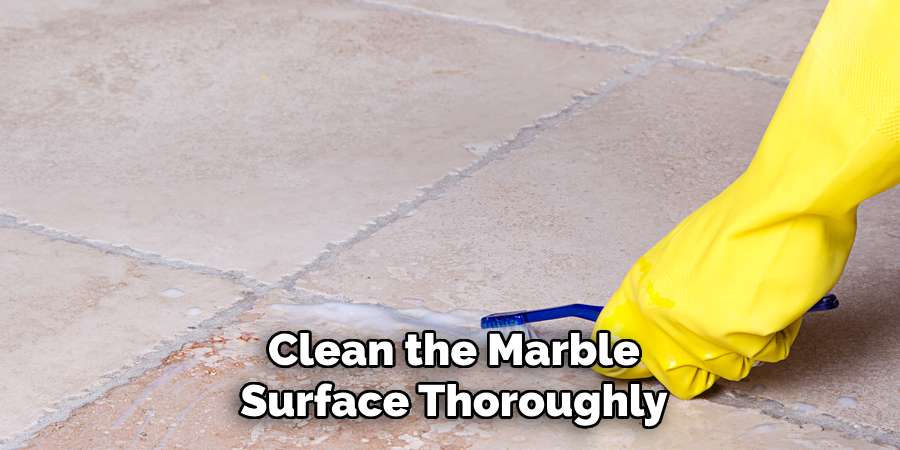
Cleaning is essential because any residue on the surface can prevent the sealer from penetrating and bonding with the marble. If your marble shower has any etch marks, you can also use a marble polishing powder to restore its shine before sealing.
Step 2: Choose the Right Sealer
When it comes to sealing marble, there are two types of sealers – topical and impregnating. Topical sealers create a protective layer on the surface of the marble, while impregnating sealers penetrate the stone’s pores and provide protection from within. An impregnating sealer is recommended for marble showers as it provides better protection against water and moisture. Choosing a high-quality sealer specifically designed for marble is also essential.
Step 3: Test the Sealer
Before applying the sealer to the entire marble shower, testing it on a small, inconspicuous area is crucial. This will ensure that the sealer does not cause any discoloration or damage to your marble. Try a different sealer or consult a professional if you notice any adverse effects. If the test area looks good, proceed with sealing the entire shower.
Step 4: Apply the Sealer
Using a clean cloth or brush, apply a thin coat of sealer on the marble surface. Work in small sections and make sure to cover all areas evenly. Let the sealer sit for about 10-15 minutes, then use a dry cloth to wipe away any excess sealer. You can also use a buffing pad or clean cloth to buff the surface gently, creating a polished finish. Make sure to follow the manufacturer’s instructions for the recommended drying time.
Step 5: Apply Multiple Coats (Optional)
For added protection, you can apply multiple coats of sealer. Wait for the first coat to dry completely, and lightly sand the surface with fine-grit sandpaper before applying subsequent coats. This will help create a smooth and even surface. Make sure to let each coat dry before applying the next one. If you are using a topical sealer, make sure to buff the surface gently between each coat.
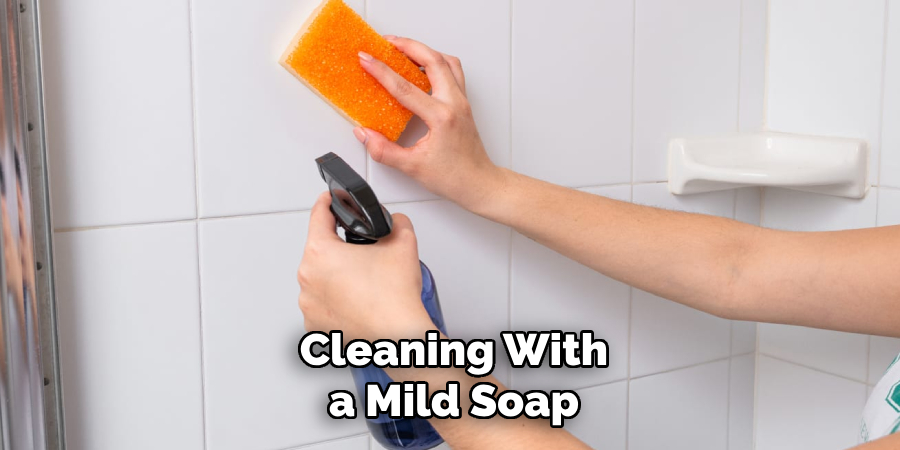
Step 6: Maintain Your Sealed Marble Shower
To ensure that your marble shower stays sealed and protected for a long time, it is essential to maintain it properly. Regular cleaning with a mild soap or marble cleaner and wiping away any spills or stains immediately will help keep your marble looking its best. Avoid using harsh chemicals or abrasive cleaners, and always test any new products on a small area before use.
Following these simple steps will help you seal your marble shower effectively and keep it looking beautiful for years to come. With proper maintenance, your marble shower will continue to add elegance and luxury to your bathroom for a long time. So, go ahead and give your marble shower the protection it deserves!
Additional Tips and Tricks to Seal Marble Shower
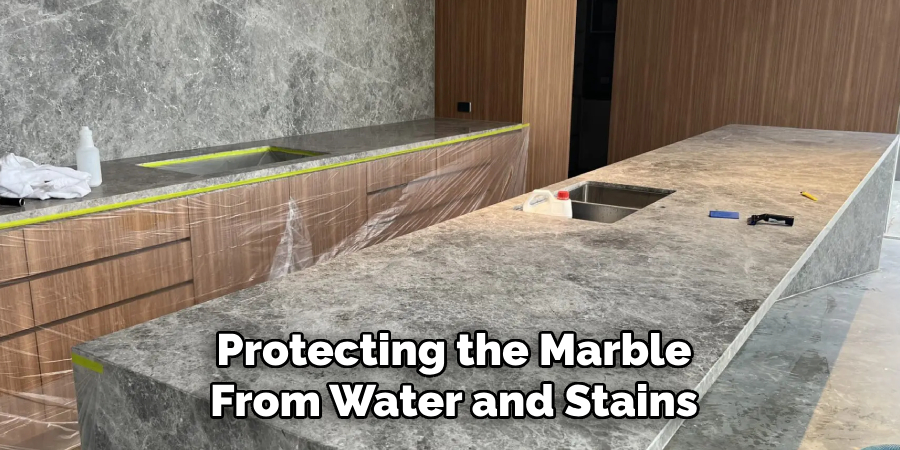
- If your marble shower is stained or discolored, try using a paste made from baking soda and water. Apply the paste to the affected area and let it sit for 10-15 minutes before scrubbing it off with a soft cloth. This can help remove tough stains without damaging the marble.
- Another natural cleaning solution for marble showers is a mixture of white vinegar and water. Spray the solution onto the shower walls and let it sit for a few minutes before wiping it off with a damp cloth. The acidity of vinegar can help dissolve hard water deposits and soap scum.
- To prevent soap scum buildup, squeegee your marble shower after each use to remove excess water. This will also help maintain the shine and prevent water spots from forming.
- Avoid using harsh or abrasive cleaners on marble showers, as they can scratch the surface and dull its shine. Stick to gentle, pH-neutral cleansers instead.
- When sealing your marble shower, make sure to cover all surfaces evenly and let the sealer dry completely before using the shower again. This will ensure that the sealant is effective in protecting the marble from water and stains.
- Regularly inspect your marble shower for any cracks or chips, as these can quickly turn into more extensive damage if left untreated. If you notice any, make sure to repair them promptly to prevent further damage.
- To maintain the luster of your marble shower, periodically use a marble polish or sealant specifically designed for use on showers. This will help protect the marble and keep it looking like new.
- Consider adding a shower mat or non-slip strips to your marble shower floor to prevent slips and falls. This is especially important if you have young children or elderly individuals using the shower.
- If you have hard water, invest in a water softener to help prevent mineral buildup on your marble shower. This will make cleaning and maintaining the shower much easier in the long run.
- Finally, remember to regularly clean and dry your marble shower fixtures, such as faucets and handles, to prevent tarnishing or corrosion.
By following these additional tips and tricks, you can ensure that your marble shower remains beautiful and pristine for years to come. Prevention and regular maintenance are key to keeping your marble shower looking its best. So, be proactive in caring for your marble shower, and it will always reward you with a luxurious and elegant bathing experience.
Things You Should Consider to Seal Marble Shower
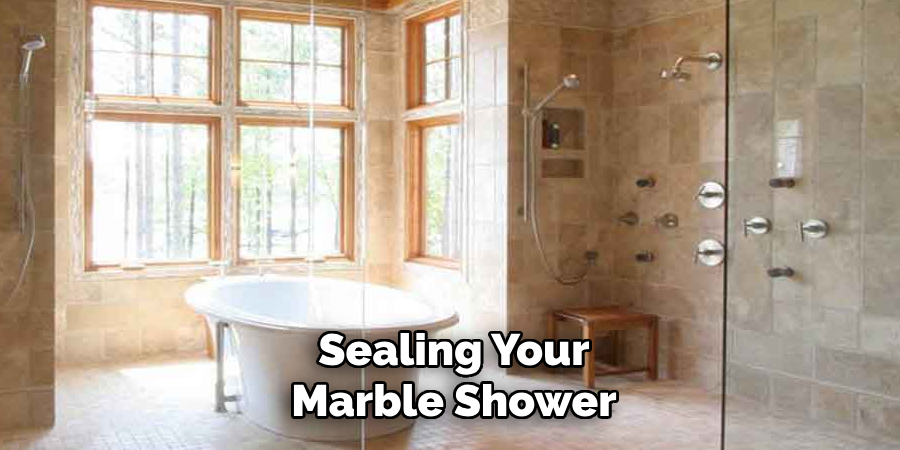
- Before sealing your marble shower, you should ensure that it is properly cleaned and free of dirt or grime. Use a pH-neutral cleaner and a soft cloth to gently wipe down the entire surface of the shower.
- Once the shower is clean, it’s important to thoroughly dry it before applying any sealant. This will help the sealant adhere better and ensure that it does its job effectively.
- Before choosing a sealant, consider the type of marble used in your shower. Some types of marble may be more porous and require a stronger sealant, while others may be more sensitive to certain chemicals. It’s always best to consult with a professional or read the manufacturer’s recommendations for the best type of sealant for your specific marble.
- It’s also important to consider the location of your marble shower. If it’s in a high-traffic area or receives a lot of water exposure, you may want to opt for a stronger and more durable sealant that can withstand wear and tear.
- Before applying the sealant, make sure to test it in a small, inconspicuous area first. This will allow you to see how the sealant interacts with your specific marble and ensure it doesn’t cause discoloration or damage.
- When applying the sealant, follow the manufacturer’s instructions carefully. Some may require multiple coats, while others may have a specific drying time between coats.
- After applying the sealant, properly ventilate the area and avoid using the shower for the recommended drying time. This will allow the sealant to fully cure and provide maximum protection.
- Regularly cleaning and maintaining your sealed marble shower is also important in prolonging its lifespan. Use a mild cleaner and soft cloth to wipe down the surface after each use, and avoid using harsh chemicals or abrasive materials.
- It’s also good to periodically check the sealant and reapply as needed, especially in high-traffic areas. Over time, the sealant may wear off, leaving your marble vulnerable to damage.
- Finally, proper care and maintenance of your marble shower can help prevent future issues such as mold growth or etching from acidic products.
Following these considerations and tips can help you effectively seal your marble shower, providing long-lasting protection and maintaining its elegance. Remember to regularly check and maintain the sealant and clean the shower properly to ensure maximum longevity. By properly sealing your marble shower, you can enjoy a luxurious and beautiful bathroom for years to come.
Maintenance Tips for Marble Shower
1. Regular Cleaning:
To keep your marble shower looking its best, it is important to clean it regularly. Use a mild cleaner and a soft cloth or sponge to gently scrub away any dirt or grime that may have accumulated on the surface of the marble. Avoid using harsh chemicals or abrasives as they can damage the marble. Be sure to rinse the shower thoroughly with water and dry it with a soft cloth afterward. Regular cleaning will prevent build-up and keep your marble looking shiny and new.
2. Protect Against Hard Water:
Hard water can leave behind mineral deposits on your marble shower, causing it to appear cloudy or dull. To protect against this, use a squeegee after each shower to remove excess water from the surface of the marble. This will help prevent any mineral deposits from forming. You can also install a water softener in your home to reduce the amount of minerals in your water.
3. Seal Your Marble:
Marble is a porous material and can easily absorb liquids if left unprotected. To prevent this, it is important to seal your marble shower regularly. There are many sealers available on the market specifically designed for marble. Follow the instructions carefully, and be sure to reapply the sealer every 6-12 months to maintain its effectiveness.
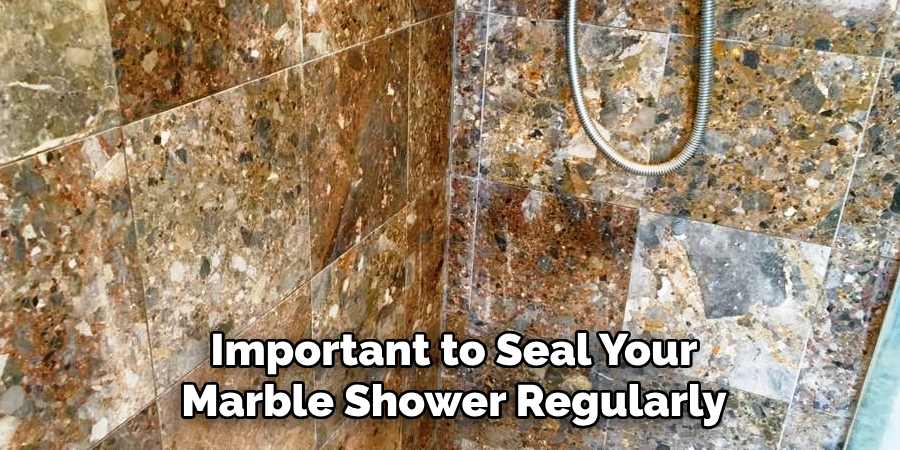
4. Avoid Harsh Cleaners:
As mentioned before, harsh chemicals or abrasives can damage marble and should be avoided when cleaning your shower. This includes products such as bleach, ammonia, and vinegar. Instead, opt for mild, non-abrasive cleaners or natural solutions such as a mixture of water and baking soda. If you need clarification on a specific product, test it on a small, inconspicuous area before using it on the entire shower.
5. Wipe Up Spills Immediately:
Accidents happen, and spills are bound to occur in the shower. It is important to immediately wipe up any spills or splashes to prevent them from soaking into the marble and causing damage. This is especially important for acidic substances such as citrus juices, wine, or vinegar that can etch the surface of marble.
6. Use Soft Brushes:
When scrubbing your shower, be sure to use soft-bristled brushes or sponges to avoid scratching the marble surface. Avoid using abrasive tools, such as steel wool or scouring pads, as they can damage the marble. Using gentle tools will help preserve the beauty and shine of your marble shower.
7. Address Stains Quickly:
If you do encounter a stain on your marble shower, it is important to address it quickly before it sets in and becomes more difficult to remove. Start by gently scrubbing the area with a mild cleaner and soft brush or sponge. If the stain persists, you can try using a poultice made of baking soda and water. Apply the paste to the stain, cover it with plastic wrap, and let it sit overnight before rinsing off.
Following these maintenance tips will help keep your marble shower looking beautiful for years to come. With regular cleaning and proper care, you can enjoy the luxurious and elegant look of marble in your bathroom.
Remember to always use gentle products and tools, protect against hard water, and quickly address any spills or stains to keep your marble shower in top condition. So go ahead, take a relaxing shower, and enjoy the beauty of your marble shower without worrying about damaging it. Happy cleaning!
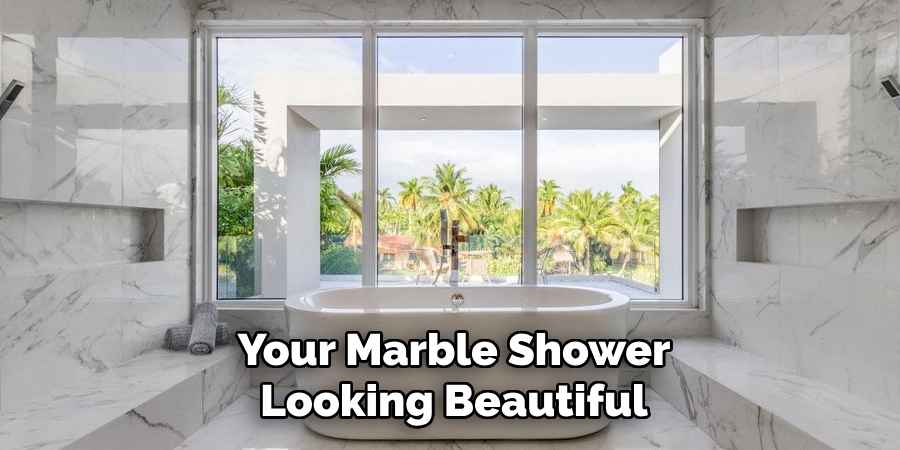
Frequently Asked Questions
What is Marble?
Marble is a natural stone formed by the transformation of limestone or dolomite through intense heat and pressure. It is composed mainly of calcite or dolomite minerals, giving it its characteristic veining patterns and various colors.
Why Should I Seal My Marble Shower?
Sealing your marble shower helps to protect it from water, stains, and other damage. A marble is a porous stone that can absorb liquids if not properly sealed, which can lead to discoloration or etching. Sealing creates a barrier on the surface of the marble, making it easier to clean and maintain.
How Often Should I Seal My Marble Shower?
Sealing your marble shower every 6-12 months is recommended, depending on the type of sealant used and the amount of use your shower receives. If you notice water no longer beads on the surface of your marble, it may be time to reseal.
How Do I Know if My Marble Shower Needs to Be Sealed?
To test if your marble shower needs to be sealed, sprinkle some water on the surface. If the water beads up and does not absorb the marble, your shower is properly sealed. However, if the water soaks in quickly, it is a sign that your marble needs to be sealed.
What Type of Sealant Should I Use on My Marble Shower?
Various sealants, including penetrating and topical sealers, are available for marble showers. It is important to choose a sealant specifically designed for natural stone, as it will provide the best protection and results.
Conclusion
Now you know how to seal marble shower and why it is important to do so. Regular sealing will help keep your marble shower looking beautiful and protect it from damage. Always use a sealant specifically made for natural stone and follow the manufacturer’s instructions for best results.
With proper care and maintenance, your marble shower will continue to be a stunning addition to your bathroom for years to come. So go ahead and enjoy your luxurious marble shower without worrying about water damage or stains! Happy sealing!

